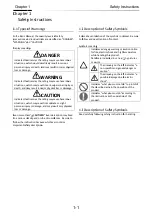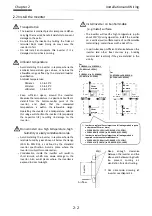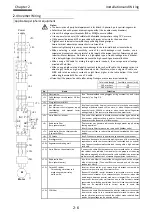
2.2 Install the Inverter
Chapter 2
2.2 Install the Inverter
Transportation
•
The inverter
carrying the inverter, handle it carefully to prevent
damage to the parts.
•
Do not carry the inverter by holding the front or
terminal block cover. Doing so may
inverter to fall.
•
Do not install and operate the inverter if it is
damaged or its parts are missing.
Ambient temperature
•
Avoid installing the inverter in a place where the
ambient temperature goes above or below the
allowable range defined by
specification.
Ambient temperature:
ND rated
LD rated
VLD rated
•
Keep
Measure the temperature in a position about 5 cm
distant from the bottom
inverter,
and
check
that
the
measured
temperature
Operating the inverter at a temperature outside
this range will shorten the inverter life (especially
the capacitor life), resulting in damage to the
inverter.
Do not install
humidity
•
Avoid installing the inverter in a place where the
relative humidity goes above or below the range
(20% to 90% RH), as defined by the standard
inverter specification. Avoid a p
inverter is subject to condensation.
•
Condensation inside the inverter will result in
short circuits, which may c
inverter.
exposed to direct sunlight.
Chapter 2
2.2 Install the Inverter
ransportation
The inverter is made of plastics
carrying the inverter, handle it carefully to prevent
damage to the parts.
Do not carry the inverter by holding the front or
terminal block cover. Doing so may
inverter to fall.
Do not install and operate the inverter if it is
damaged or its parts are missing.
mbient temperature
Avoid installing the inverter in a place where the
ambient temperature goes above or below the
allowable range defined by
specification.
Ambient temperature:
ND rated
: -10 to 50°C
LD rated
: -10 to 45°C
VLD rated
: -10 to 40°C
sufficient space around the inverter.
Measure the temperature in a position about 5 cm
distant from the bottom
inverter,
and
check
that
the
measured
temperature is within the allowable range.
Operating the inverter at a temperature outside
this range will shorten the inverter life (especially
the capacitor life), resulting in damage to the
inverter.
Do not install on
umidity or easily condensa
Avoid installing the inverter in a place where the
relative humidity goes above or below the range
(20% to 90% RH), as defined by the standard
inverter specification. Avoid a p
inverter is subject to condensation.
Condensation inside the inverter will result in
short circuits, which may c
inverter. Also avoid places where the inverter is
exposed to direct sunlight.
2.2 Install the Inverter
is made of plastics component
carrying the inverter, handle it carefully to prevent
damage to the parts.
Do not carry the inverter by holding the front or
terminal block cover. Doing so may
Do not install and operate the inverter if it is
damaged or its parts are missing.
mbient temperature
Avoid installing the inverter in a place where the
ambient temperature goes above or below the
allowable range defined by the standard inverter
Ambient temperature:
10 to 50°C
10 to 45°C
10 to 40°C
ent space around the inverter.
Measure the temperature in a position about 5 cm
distant from the bottom-center poi
inverter,
and
check
that
the
measured
is within the allowable range.
Operating the inverter at a temperature outside
this range will shorten the inverter life (especially
the capacitor life), resulting in damage to the
a high temperature, high
or easily condensa
Avoid installing the inverter in a place where the
relative humidity goes above or below the range
(20% to 90% RH), as defined by the standard
inverter specification. Avoid a p
inverter is subject to condensation.
Condensation inside the inverter will result in
short circuits, which may cause
Also avoid places where the inverter is
exposed to direct sunlight.
component. When
carrying the inverter, handle it carefully to prevent
Do not carry the inverter by holding the front or
terminal block cover. Doing so may cause the
Do not install and operate the inverter if it is
Avoid installing the inverter in a place where the
ambient temperature goes above or below the
the standard inverter
ent space around the inverter.
Measure the temperature in a position about 5 cm
center point of the
inverter,
and
check
that
the
measured
is within the allowable range.
Operating the inverter at a temperature outside
this range will shorten the inverter life (especially
the capacitor life), resulting in damage to the
a high temperature, high
or easily condensation area
Avoid installing the inverter in a place where the
relative humidity goes above or below the range
(20% to 90% RH), as defined by the standard
inverter specification. Avoid a place where the
inverter is subject to condensation.
Condensation inside the inverter will result in
ause damage to the
Also avoid places where the inverter is
2-2
. When
carrying the inverter, handle it carefully to prevent
Do not carry the inverter by holding the front or
cause the
Do not install and operate the inverter if it is
Avoid installing the inverter in a place where the
ambient temperature goes above or below the
the standard inverter
ent space around the inverter.
Measure the temperature in a position about 5 cm
nt of the
inverter,
and
check
that
the
measured
is within the allowable range.
Operating the inverter at a temperature outside
this range will shorten the inverter life (especially
the capacitor life), resulting in damage to the
a high temperature, high
area
Avoid installing the inverter in a place where the
relative humidity goes above or below the range
(20% to 90% RH), as defined by the standard
lace where the
Condensation inside the inverter will result in
to the
Also avoid places where the inverter is
Air flow
For
P1-00044
(P1-
or
P1-00041
(P1-
or more
Install inverter on
(e.g. metal) surface.
•
The inverter will reach a high temperature (up to
about 150°C) during operation. Install the inverter
on a vertical wall surface made of nonflammable
material (e.g., metal) to avoid the risk of fire.
•
In particular, keep
inverter and other heat sources (e.g., braking
resistors and reactors) if they are installed in the
vicinity.
In
v
e
rt
e
r
Air flow
Wall
For
00044-L to P1-02950
-004L to P1-550L)
00041-H to P1-01800
-007H to P1-550H)
In order to replace life cycle parts on following models require
a clearance of 22cm or more:
• P1-00800-L (P1
• P1-00380-H (P1
In order to replace life cycle parts on following models is
required to remove the installed units:
• P1-00044-L (P1
• P1-00041-H (P1
5 cm
or more
10 cm
or more
10 cm
or more
Installation and Wiring
nstall inverter on nonflammable
metal) surface.
The inverter will reach a high temperature (up to
about 150°C) during operation. Install the inverter
on a vertical wall surface made of nonflammable
material (e.g., metal) to avoid the risk of fire.
In particular, keep sufficient distance between the
inverter and other heat sources (e.g., braking
resistors and reactors) if they are installed in the
•
Keep
enough
clearance
between the inverter and the
above and below
to
prevent
ventilation from
For dimension drawing of
inverter
Wall
02950-L
550L)
01800-H
550H)
order to replace life cycle parts on following models require
a clearance of 22cm or more:
L (P1-150L) to P1-
H (P1-150H) to P1
In order to replace life cycle parts on following models is
remove the installed units:
L (P1-004L) to P1-
H (P1-007H) to P1
or more
5 cm
or more
or more
For
P1
(P1
Installation and Wiring
nonflammable
metal) surface.
The inverter will reach a high temperature (up to
about 150°C) during operation. Install the inverter
on a vertical wall surface made of nonflammable
material (e.g., metal) to avoid the risk of fire.
sufficient distance between the
inverter and other heat sources (e.g., braking
resistors and reactors) if they are installed in the
Keep
enough
clearance
between the inverter and the
above and below
to
prevent
ventilation from
For dimension drawing of
inverter see chapter
order to replace life cycle parts on following models require
a clearance of 22cm or more:
-01240-L (P1-220L)
150H) to P1-00620-H (P1-220H)
In order to replace life cycle parts on following models is
remove the installed units:
-00600-L (P1-110L)
007H) to P1-00310-H (P1-110H)
30 cm
or more
30 cm
or more
5 cm
or more
For
P1-02160-H to P1
(P1-750H to P1-1320H)
Installation and Wiring
nonflammable
The inverter will reach a high temperature (up to
about 150°C) during operation. Install the inverter
on a vertical wall surface made of nonflammable
material (e.g., metal) to avoid the risk of fire.
sufficient distance between the
inverter and other heat sources (e.g., braking
resistors and reactors) if they are installed in the
Keep
enough
clearance
between the inverter and the
above and below wiring ducts
cooling
air
ventilation from obstructing.
For dimension drawing of
chapter 2-5.
order to replace life cycle parts on following models require
220L)
220H)
In order to replace life cycle parts on following models is
110L)
110H)
5 cm
or more
30 cm
or more
30 cm
or more
H to P1-03610-H
1320H)
Installation and Wiring
The inverter will reach a high temperature (up to
about 150°C) during operation. Install the inverter
on a vertical wall surface made of nonflammable
sufficient distance between the
inverter and other heat sources (e.g., braking
resistors and reactors) if they are installed in the
Keep
enough
clearance
between the inverter and the
wiring ducts
cooling
air
obstructing.
For dimension drawing of
order to replace life cycle parts on following models require
or more
Summary of Contents for P1-00041HFEF
Page 6: ...0 5 Contents Contents Memo ...
Page 42: ...2 26 Chapter 2 Installation and Wiring Memo ...
Page 129: ...Index Index 3 memo ...
Page 130: ...Index Index 4 memo ...
















































